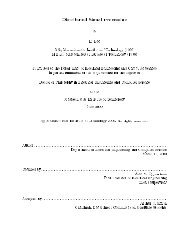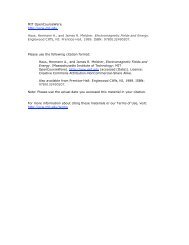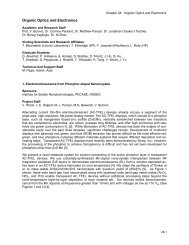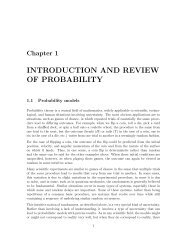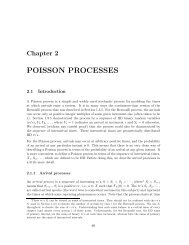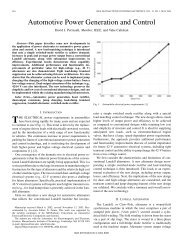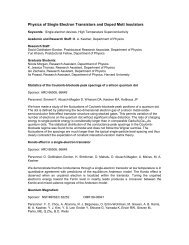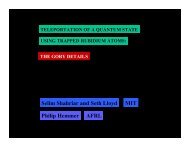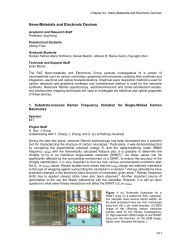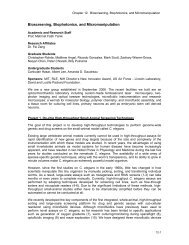A 24 Gb/s Software Programmable Analog Multi-Tone - Research ...
A 24 Gb/s Software Programmable Analog Multi-Tone - Research ...
A 24 Gb/s Software Programmable Analog Multi-Tone - Research ...
You also want an ePaper? Increase the reach of your titles
YUMPU automatically turns print PDFs into web optimized ePapers that Google loves.
AMIRKHANY et al.: A <strong>24</strong> GB/S SOFTWARE PROGRAMMABLE ANALOG MULTI-TONE TRANSMITTER 1007<br />
weakly correlated sequence. As long as the delay is larger than<br />
the delay spread of the pulse response of the channel, such correlation<br />
has negligible effect on the eye diagrams. Fig. 10(c) shows<br />
that discernible, although perhaps too small to be practical, eyes<br />
observed on the scope at 36 <strong>Gb</strong>/s in 8 PAM mode. Similar ideas<br />
can be applied to program the transmitter in higher multi-PAM<br />
BB modes as well as 2-channel AMT with 6 GS/s (12 <strong>Gb</strong>/s)<br />
sub-channels.<br />
Fig. 11. (a) Measured pulse responses of the 4 phases of the DAC. (b) LTI<br />
equalized BB 4 PAM 28 <strong>Gb</strong>/s eyes on a scope. (b) Cyclically time-variant equalized<br />
BB 4 PAM 28 <strong>Gb</strong>/s eyes on a scope.<br />
Fig. 9(b) shows the measured frequency response of a 3-stub<br />
16 in FR4 trace. The first notch frequency is slightly above<br />
1 GHz. A property of AMT, and the implemented transmitter<br />
in particular, is that the entire frequency response of the system<br />
can be scaled by changing a single clock frequency. In this case<br />
in order to place the 3 dB bandwidth of the BB sub-channel<br />
around 1.1 GHz, the input clock frequency to the transmitter is<br />
reduced from 12 to 9.2 GHz. Fig. 9(c) shows the measured eye<br />
diagrams when only two of the sub-channels are used in 2 PAM<br />
mode for an aggregate data-rate of 4.6 <strong>Gb</strong>/s. Again the receiver<br />
[see Fig. 9(d)] is implemented in MATLAB to post process<br />
measured data at the output of the channel. If the transmitter is<br />
configured in 2 PAM BB mode over the same channel, no open<br />
eyes can be observed on the scope beyond 2.6 <strong>Gb</strong>/s.<br />
V. OTHER TRANSMITTER OPERATION MODES<br />
The degrees of freedom available in the transmitter enable<br />
supporting more complex multi-PAM (for example 8 PAM) BB<br />
modulations. In addition the freedom in choosing the tap coefficients<br />
for different branches of the parallelized equalizer enables<br />
digital compensation of the analog distortions through cyclic<br />
time-variant equalization. These modes are briefly described in<br />
this section.<br />
A. <strong>Multi</strong>-PAM Operation<br />
By programming the correct tap coefficients to the equalizer,<br />
the transmitter can support signal transmission in 2 -PAM<br />
mode. Operation in 8 PAM, for example, is enabled<br />
based on the observation that an 8 PAM sequence can<br />
be decomposed to the summation of a 4 PAM sequence and a<br />
2 PAM sequence as shown in Fig. 10(a). Fig. 10(b) shows the<br />
transmitter configured to operate in 8 PAM mode, as a 2-way<br />
parallelized system where each of the parallel branches consists<br />
of two branches which together generate an equalized 8<br />
PAM output. In this mode the transmitter can only support up<br />
to 18 <strong>Gb</strong>/s of uncorrelated data since two of the branches are<br />
operating in 2 PAM mode instead of 4 PAM. However, in order<br />
to show the operating limits of the analog circuits in the transmitter,<br />
some of the equalizer taps were used to delay the input<br />
sequence for a few cycles and add it back to itself. This effectively<br />
doubles the throughput by creating a virtual source with a<br />
B. Linear Cyclic Time-Variant Equalization<br />
The transmitter also supports cyclic time-variant equalization.<br />
This mode is useful for applications utilizing wide-band<br />
interleaved data converters, where the response from the input<br />
to the output may be different from time to time due to the mismatch<br />
between the interleaved paths. For example, in the transmitter<br />
described in this paper, four different paths can be identified<br />
from the input of the DAC to its output. Fig. 11(a) shows<br />
the estimated pulse responses for these four paths. It can be seen<br />
that one path is visibly different from the other three. This difference<br />
in the responses makes the system cyclically time-variant<br />
rather than time-invariant. Therefore, as long as the system is<br />
treated like an LTI system, the time-variant nature manifests itself<br />
as analog distortion. Fig. 11(b) shows the measured eye diagrams<br />
when the transmitter is operating in BB 4 PAM 28 <strong>Gb</strong>/s<br />
mode, and LTI equalization is performed. Measured signal to<br />
interference and distortion ratio (SIDR) at the middle of the eye<br />
is 26 dB. However, if the four phases of the 4-way parallelized<br />
equalizer in the transmitter are programmed independently to<br />
perform cyclic time-variant equalization [16], measured SIDR<br />
improves to 31 dB [see Fig. 11(c)], which indicates at least 5 dB<br />
of the distortion is related to the mismatch. 3<br />
VI. CONCLUSION<br />
A software programmable transmitter can be implemented by<br />
parallelizing a conventional FIR filter and letting each of the<br />
parallel branches to be programmed independently. The architecture<br />
of the transmitter enables supporting bandwidth scalable<br />
AMT and 2 -PAM BB transmission. In addition, the degrees of<br />
freedom available in an AMT system and in the transmitter in<br />
particular, enable cyclic time-variant equalization to compensate<br />
for analog distortions of the system. The additional degrees<br />
of freedom come at a small cost, since the additional equalizer<br />
tap values which are needed only add a small additional area to<br />
the chip, but do not increase the active power.<br />
REFERENCES<br />
[1] M. Meghelli et al., “A 10- <strong>Gb</strong>/s 5-Tap DFE/4-Tap FFE transceiver in<br />
90-nm CMOS technology,” IEEE J. Solid-State Circuits, vol. 41, no.<br />
12, pp. 2885–2900, Dec. 2006.<br />
[2] R. Palmer et al., “A 14 mW 6.25 <strong>Gb</strong>/s transceiver in 90 nm CMOS for<br />
serial chip-to-chip communication,” in IEEE ISSCC Dig. Tech. Papers,<br />
2006, pp. 440–441.<br />
[3] M. Harwood et al., “A 12.5 <strong>Gb</strong>/s SerDes in 65 nm CMOS using a<br />
baud-rate ADC with digital receiver equalization and clock recovery,”<br />
in IEEE ISSCC Dig. Tech. Papers, 2006, pp. 436–437.<br />
[4] B. Casper et al., “A 20 <strong>Gb</strong>/s forwarded clock transceiver in 90 nm<br />
CMOS,” in IEEE ISSCC Dig. Tech. Papers, 2006, pp. 90–91.<br />
3 The actual SDR is 32 dB which corresponds to 6 dB improvement in SDR.<br />
The 1 dB difference between SDR and SIDR is due to the residual interference<br />
which cannot be suppressed to better than 34 dB with only transmit equalization.



